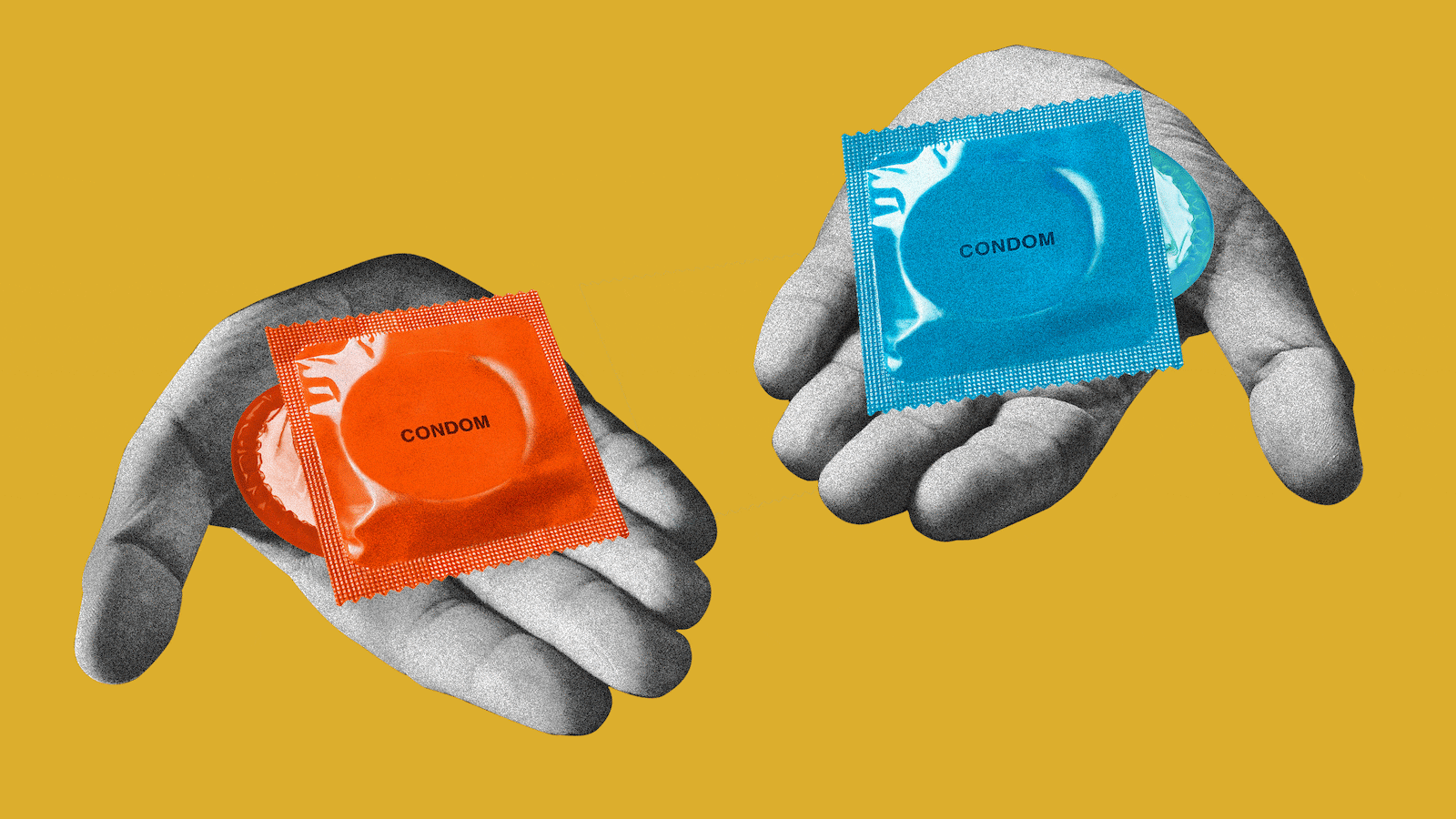Every male latex condom you buy at the store has been rigorously tested for even the tiniest holes—pulled over a phallic piece of metal called a “mandril” and subjected to an intense electric field. Since rubber doesn’t conduct electricity, and latex condoms are made with natural rubber, if any electricity at all passes through the condom to the mandril, the condom will be scrapped.
Beyond this, random samplings of every type of latex condom are tested in myriad ways to meet international standards. They’ll be stretched to the breaking point with an air pump, or a cross section of a condom will be pulled apart on a machine to see how far it can stretch. Others will be filled with water and tested for leaks. Condoms that fail to pass any of these tests won’t make it to market. Testing requirements for condoms in the United States are more strenuous than many other products—medical gloves, for example.
These standards are determined by an international group of experts, according to Milla Impola, marketing communications manager for the Boston-based condom manufacturing and testing company Global Protection Corp. “Such guidelines include, for instance, how much air and water a condom must be able to hold without bursting or leaking,” said Impola.
However, despite the rigor of machine testing for condoms, male latex condoms do not need to be tested on human beings for efficacy to get Food and Drug Administration clearance. So are Trojans as effective as Durex as effective as Kimonos for pregnancy prevention? Or are ribbed condoms any different than ultra thin or normal condoms for preventing STIs?
“Nobody knows,” said Diana Zuckerman, president of the National Center for Health Research—an independent, nonprofit organization that conducts public interest medical research. That’s because new types of natural and synthetic latex condoms are cleared by the FDA under what are called “substantial equivalency” guidelines—specifically for products that are similar to those already on the market.
As a result, any condom that passes a set of material tests showing that it’s similar to other latex condoms doesn’t need to be tested on people. And, unlike with newer products, the FDA has never required human clinical trials for male latex condoms, because they were around before 1976, when Congress tightened device regulation.
“The thing to realize is that any product that was already on the market before was going to be basically grandfathered and allowed to be sold usually without much regulation at all,” says Zuckerman. Impola said the FDA has regulated condoms since the 1930s. Back then, condoms were the most cutting-edge contraception available and thus more strictly tested than many other products, but today, newer contraceptive devices are tested more rigorously than male latex condoms.
According to a study in Contraceptive Journal, the evidence we have that condoms work is either taken from surveys of people in the real world using condoms, or from lab tests instead of human trials.The organizations that set the standards for physical testing include the International Organization for Standardization (ISO) and ASTM International. Alison Hunt, a spokesperson for the FDA, said the agency folds these standards into its guidelines as well.
All this sets condoms apart from contraceptives like the pill or IUDs, which are tested in human clinical trials before receiving FDA approval. Some clinical studies have been done to test the efficacy of condoms retrospectively—either looking at pregnancy rates, breakage and slippage or both—and these studies continue to prove that condoms do work. But there is no consistent testing of different condoms brand to brand or type to type. So when you read the label on a box of Trojans—“Condoms are highly effective against pregnancy, less than 2 women in 100 get pregnant during one year of typical correct and consistent use”— know that this figure comes from general surveys of condoms, and not a test of the specific type condom you’re about to use. The 2 percent figure appears to be taken from a 2011 survey which is cited in much literature on contraceptive efficacy, including Planned Parenthood and CDC literature.
But results of condom surveys fluctuate drastically for unknown reasons. According to the Guttmacher institute, in the 1970s, the typical use failure rate of condoms was only 7 percent—meaning 7 percent of women using condoms were pregnant within a year. (Typical use failure rates reflect how people actually use condoms while perfect use failure rates only include people who use condoms completely correctly—pregnancy can occur due to common errors like failing to pull out fast enough after sex, or failing to hold the condom at the base during removal).
Since 2011, the typical use failure rate has fluctuated between 13 and 18 percent, according to a variety of studies. There are many factors that could influence these variations—like education about correct condom use, for example. But different brands and types of condoms could also have something to do with it. Unless we study the comparative efficacy of condoms, we can’t know, said Zuckerman. “I think it would be appropriate if we had studies comparing different brands of condoms and how effective they are,” she said.
According to Impola, in the U.S., all condoms are held to the same minimum standard. “This is why condom manufacturers cannot use words like ‘safer’ in their marketing and advertising,” she said. From her perspective, because all condoms are held to the same physical standards, human trials aren’t necessary. “We don’t necessarily see a benefit in testing different condoms or brands to determine the ‘best’ condom,” she said, adding, “We do think it’s important for consumers to try different condoms to determine the best product for them.”
But the relatively easy approval process for latex condoms might be discouraging condom companies from making condoms out of new materials, says Zuckerman. A wide variety of latex condoms, from tingling, to mint flavored, to even a package that included three different types of condoms (ribbed, dotted and contoured) were all cleared by the FDA as “substantially equivalent” to existing latex condoms with no need for an efficacy trial. However, in order for a condom made out of something new to get on the market, it must go through both a preliminary “slippage and breakage trial” and a human efficacy trial—which takes time, manpower and money.
“It could cost up to around a million dollars to go through such a clinical trial,” Impola said.
In 2013, the Bill and Melinda Gates’ Foundation gave grants to 11 engineers as part of an initiative to create a better condom. But because of the costs and time required to get a new type of condom approved, none of the new products—including one made out of a substance called “hydrogel” and one that self-lubricates—are yet on the global market.
Condoms, however, remain the only method that reduces the risk of both pregnancy and sexually transmitted infections—and they are the best method for preventing certain STIs including gonorrhea, syphilis and chlamydia. While PrEP has entered the market as an important prophylactic to fight HIV, those who don’t know they are positive may not use it. And for those trying to avoid pregnancy, even the bleakest failure rates for condoms—18 percent—means they are still far better than using nothing. Fertile, opposite-sex, sexually active couples who don’t use any method of contraception have about an 86-percent chance of getting pregnant in a year, so the chances of avoiding pregnancy are almost five times better with condoms.
“The greatest fear of HIV is gone because of PrEP. The greatest fear of pregnancy is gone because there are so many alternatives,” said Zuckerman. But there are still 43 million women at risk for unintended pregnancy in the U.S., and in 2016, nearly 40,000 Americans were newly infected with HIV. Statistics like these show that condoms—the quickest, cheapest way to protect yourself if you’re not already on birth control or PrEP—still have a place.
“They are obviously more effective at preventing STDs than non-barrier contraceptives, which aren't effective at all,” said Zuckerman. Current standard don’t make clear if male latex condoms are equally safe, she said, adding, “I think people have learned to kind of live with that uncertainty.”






